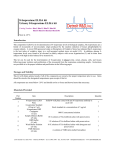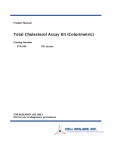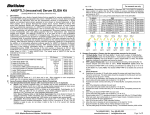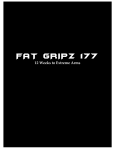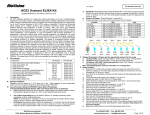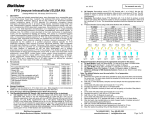Download ANGPTL6 (human) Serum ELISA Kit
Transcript
BioVision ANGPTL6 (human) Serum ELISA Kit d) (Catalog #K4916-100; 100 assays; Store kit at 4°C) I. II. Description: Seven angiopoietin-like proteins (ANGPTLs) share the characteristic protein structure of the angiopoietin family (ANG), but differ in their inability to bind antiopoietin receptor, Tie-2. ANGPTL6 was originally named angiopoietin-related growth factor (AGF) having an N-terminal coiled-coil-like domain and a C-terminal fibrinogen-like domain, both of which are conserved in ANG. It is a circulating protein secreted by liver that induces angiogenesis by direct effect of epidermal ANGPTL6 on endothelial cells and proliferation of skin cells, and thereby promotes wound healing. 80% of Angptl6 -/- mice died at about embryonic day 13. The surviving null mice developed marked obesity, lipid accumulation in skeletal muscle and liver, and insulin resistance accompanied by reduced energy expenditure relative to controls. Conversely, mice with constitutive overexpression of ANGPTL6 showed leanness and increased insulin sensitivity resulting from increased energy expenditure, and were also protected from high-fat diet-induced obesity, insulin resistance, and non-adipose tissue steatosis. This assay is a sandwich Enzyme Linked-Immunosorbent Assay (ELISA) for quantitative determination of human ANGPTL6 in biological fluids. A monoclonal antibody specific for ANGPTL6 has been precoated onto the 96well microtiter plate. Standards and samples are pipetted into the wells for binding to the coated antibody. After extensive washing to remove unbound compounds, ANGPTL6 is recognized by the addition of a purified polyclonal antibody specific for ANGPTL6 (Detection Antibody). After removal of excess polyclonal antibody, HRP conjugated anti-rabbit IgG (Detector) is added. Following a final washing, peroxidase activity is quantified using the substrate 3,3’,5,5’tetramethylbenzidine (TMB). The intensity of the color reaction is measured at 450 nm after acidification and is directly proportional to the concentration of ANGPTL6 in the samples. The assay range is 1.56 – 100 ng/ml ANGPTL6/ml. The lowest level of ANGPTL6 that can be detected by this assay is 1.2 ng/ml. Kit Contents: Component For research use only rev. 02/14 100 Assays Part Number 1 plate coated with human ANGPTL6 Antibody (12 x 8-well strips) K4916-100-1 K4916-100-2 Wash Buffer 10X (50 ml) K4916-100-3 Diluent 5X (50 ml) K4916-100-4 Detection Antibody (12 ml) K4916-100-5 Detector 100X (HRP Conjugated anti-rabbit IgG) 1 vial K4916-100-6 human ANGPTL6 Standard (lyophilized) (200 ng) K4916-100-7 human ANGPTL6 QC sample (lyophilized) 1 vial K4916-100-8 Substrate Solution I (TMB) (6 ml) K4916-100-9 Substrate Solution II (Peroxidase) (6 ml) K4916-100-10 Stop Solution (12 ml) K4916-100-11 3 plate sealers (plastic film) 3 sealers III. Storage Conditions: Reagents must be stored at 2 - 8°C when not in use. Bring reagents to room temperature before use. Do not expose reagents to temperatures greater than 25°C. IV. Assay Procedure (Read the ENTIRE Protocol Before Proceeding) 1. Test Samples/Standards/QC Sample: (We recommend these be run in duplicate) a) Serum: Use a serum separator tube. Let samples clot at room temperature for 30 min before centrifugation for 20 min at 1000 x g. Assay freshly prepared serum or store serum in aliquots at -20°C for future use. Avoid repeated freeze/thaw cycles. b) Plasma: Collect using heparin, EDTA or citrate as an anticoagulant. Centrifugation for 15 min at 1000 x g within 30 min of collection. Assay freshly prepared plasma or store in aliquots at -20°C for future use. Avoid repeated freeze/thaw cycles Note: Serum, Plasma, Urine or Cell Culture Supernatant have to be diluted in Diluent 1X. Samples containing visible precipitates must be clarified before use. As starting point 1/10 dilution of serum or plasma are recommended. c) QC Sample: Reconstitute Human ANGPTL6 QC sample with 1 ml of dH2O. Mix the QC Sample to ensure complete reconstitution. Allow to sit for a minimum of 15 min. The QC Sample is ready to use-do not dilute it (refer to the C of A for current QC Sample concentration). BioVision Incorporated 155 S. Milpitas Boulevard, Milpitas, CA 95035 USA e) f) g) Standards: Reconstitute human ANGPTL6 Standard with 1 ml of dH2O to produce a stock solution (200 ng/ml). Mix the Stock solution to ensure complete reconstitution. Allow to sit for a minimum of 15 min. The reconstituted standard should be aliquoted and stored at -20°C. Prepare 1X Diluent: Dilute 5X Diluent 1:4 with dH2O. Prepare Substrate Solution I and II: Mix together in equal volumes within 15 minutes of use. Prepare Standard Curve using 2-fold serial dilutions with 1X Diluent: To obtain 100 ng/ml 50 ng/ml 25 ng/ml 12.5 ng/ml 6.25 ng/ml 3.13 ng/ml 1.56 ng/ml 0 ng/ml 300 µl Add 300 µl of ANGPTL6 (200 ng/ml) 300 µl of ANGPTL6 (100 ng/ml) 300 µl of ANGPTL6 (50 ng/ml) 300 µl of ANGPTL6 (25 ng/ml) 300 µl of ANGPTL6 (12.5 ng/ml) 300 µl of ANGPTL6 (6.25 ng/ml) 300 µl of ANGPTL6 (3.13 ng/ml) 300 µl of Diluent 1X 300 µl 200 100 ng/ml ng/ml 300 µl 300 µl 300 µl Into 300 µl of 1X Diluent 300 µl of 1X Diluent 300 µl of 1X Diluent 300 µl of 1X Diluent 300 µl of 1X Diluent 300 µl of 1X Diluent 300 µl of 1X Diluent Empty tube 300 µl 50 25 12.5 6.25 ng/ml ng/ml ng/ml ng/ml 300 µl 3.13 1.556 ng/ml ng/ml 0 ng/ml 2. Reagent Preparation: (Prepare just the appropriate amounts for the assay) a) 1X Wash Buffer: Dilute 10X Wash Buffer 1: 9 with dH2O to obtain 1X Wash Buffer. b) 1X Diluent: Dilute 5X Wash Buffer 1: 4 with dH2O to obtain 1X Diluent. c) 1X Detector 100X (HRP Labeled Streptavidin): Dilute 100X Detector 1: 99 with 1X Diluent to obtain 1X Detector. Note: The diluted Detector must be used within 1 hr of preparation 3. Assay Protocol: a) Determine the number of 8-well strips needed for assay and insert them into the frame for current use. The extra strips should be resealed in the foil pouch and can be stored at 4°C for up to 1 month. b) Add 100 µl of the Standards, Samples and QC Sample into the appropriate wells in duplicate. c) Cover plate with plate sealer and incubate for 1 hr at 37°C. d) Aspirate and wash x 3 with 300 µl of 1X Wash Buffer. e) Warm Detection Antibody to room temperature. Add 100 µl to each well and tap gently on the side of the plate to mix. f) Cover plate with plate sealer and incubate for 1 hr at 37°C. g) Aspirate and wash x 3 with 300 µl of 1X Wash Buffer. h) Add 100 µl of the 1X Detector to each well. i) Cover plate with plate sealer and incubate for 1 hr at 37°C. j) Remove plate from 37°C, aspirate and wash x 5 with 300 µl of 1X Wash Buffer. k) After last wash, tap inverted plate on a stack of paper towels. Complete removal of liquid is essential for good performance. l) Add 100 µl to each well of mixed substrate solution. m) Allow the color to develop at room temperature in the dark for 30 min. n) Stop the reaction by adding 100 µl of Stop Solution to each well. o) Tap the plate gently to ensure thorough mixing. The substrate reaction yields a blue solution that turns yellow when Stop Solution is added.Caution: Stop Solution is a Corrosive Solution p) Measure the OD at 450 nm in an ELISA plate reader within 30 min. Tel: 408-493-1800 | Fax: 408-493-1801 www.biovision.com | [email protected] Page 1 of 2 BioVision V. Calculations: a) b) c) d) For research use only rev. 02/14 Average the duplicate readings for each Standard, QC Sample and Test Sample and subtract the average blank value (obtained with the 0 ng/ml point). Generate a Standard Curve by plotting the average absorbance on the horizontal (X) axis vs. the corresponding concentration (µg /ml) on the vertical (Y) axis. (See Typical Data below) Calculate the Test Sample ANGPTL6 concentrations by interpolation of the Standard Curve regression curve as shown below in the form of a quadratic equation. If the Test Samples were diluted, multiply the interpolated values by the dilution factor to calculate the corrected human ANGPTL6 concentrations. 4. Expected values: ANGPTL6 levels range in plasma and serum from 50 to > 800 ng/ml (from healthy donors). Technical Hints and Limitations: • It is recommended that all standards, QC sample and samples be run in duplicate. • Do not combine leftover reagents with those reserved for additional wells. • Reagents from the kit with a volume less than 100 µl should be centrifuged. • Residual wash liquid should be drained from the wells after last wash by tapping the plate on absorbent paper. • Crystals could appear in the 10X solution due to high salt concentration in the stock solutions. Crystals are readily dissolved at room temperature or at 37°C before dilution of the buffer solutions. • Once reagents have been added to the 8-well strips, DO NOT let the strips DRY at any time during the assay. • Keep Substrate Solution protected from light. • The Stop Solution consists of phosphoric acid. Although diluted, the Stop Solution should be handled with gloves, eye protection and protective clothing. Troubleshooting: PROBLEM VI. 1. Performance Characteristics: Intra-assay precision: Six samples of known concentrations of human ANGPTL6 were assayed in replicates 8 times to test precision within an assay. Samples Mean SD CV (%) 1 178.45 5.88 3.30 2 662.79 11.25 1.70 3 584.63 9.88 1.69 4 397.97 12.92 3.25 5 739.63 13.15 1.78 6 546.35 8.27 1.51 2. Inter-assay precision: Six samples of known concentrations of human assayed in 8 separate assays to test precision between assays. Samples 1 2 3 4 5 6 Mean 179.27 610.74 245.16 747.29 397.97 561.28 SD 6.03 52.20 10.44 48.71 12.92 45.45 CV (%) 3.36 8.55 4.26 6.52 3.25 8.10 n 8 8 8 8 8 8 ANGPTL6 were n 8 8 8 8 8 8 POSSIBLE CAUSES SOLUTIONS Omission of key reagent Check that all reagents have been added in the correct order. Washes too stringent Use an automated plate washer if possible. No signal or weak Incubation times inadequate signal Plate reader settings not optimal Incorrect assay temperature Concentration of detector too high Use recommended dilution factor. Inadequate washing Ensure all wells are filling wash buffer and are aspirated completely. Wells not completely aspirated Completely aspirate wells between steps. Reagents poorly mixed Be sure that reagents are thoroughly mixed. Omission of reagents Be sure that reagents were prepared correctly and added in the correct order. Dilution error Check pipetting technique and double-check calculations. High background Poor standard curve Unexpected results Incubation times should be followed as indicated in the manual. Verify the wavelength and filter setting in the plate reader. Use recommended incubation temperature. Bring substrates to room temperature before use. 3. Recovery: When samples (serum) are spiked with known concentrations of human ANGPTL6, the recovery averages 96% (range from 80 to 105%). Samples 1 2 3 Average Recovery (%) 88.77 101.17 100.43 Range (%) 85-95 95-105 95-105 BioVision Incorporated 155 S. Milpitas Boulevard, Milpitas, CA 95035 USA FOR RESEARCH USE ONLY! Not to be used on humans. Tel: 408-493-1800 | Fax: 408-493-1801 www.biovision.com | [email protected] Page 2 of 2



